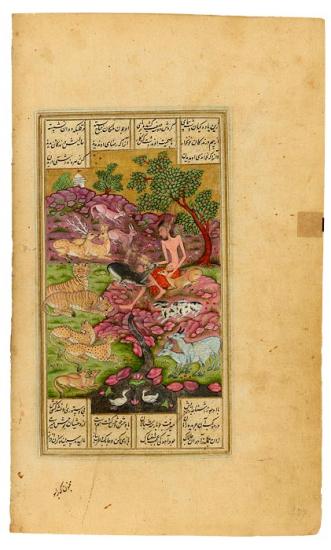
Majnūn Surrounded by Pairs of Animals in the Wilderness
Khamsa (Quintet), in Persian, written by Mullā Fatḥ Muḥammad
Purchased by Pierpont Morgan, 1910
Because of his love for Lailā, Majnūn not only became a madman but also a poet. A father had lost a son, and he was a prisoner in the land of love. He became increasingly separated from his friends, taking refuge in the wilderness. The wild animals did not attack him, or each other, becoming tame and friendly with the stranger in their midst. He became their friend and master, and they protected him. Although he withdrew from public society, the intensity of his love for Lailā never diminished.
Lailā va Majnūn (1188), a Persian Romeo and Juliet, is the third poem of the Khamsa (Quintet), a multi-part work by the poet Niẓāmī. The story is based on two real-life seventh-century lovers.
Persian poetry
The Persians loved their poetry and their poets, though the Qur˒an warned against believing their words (sura 69.41) and "those straying in evil who follow them" (sura 26.224). While Arabic was the first language of Islam and the language of the Qur˒an, Persian was favored by poets. Even Firdausī's (940–1020) celebrated Shāhnāma (Book of Kings), the national epic of Persian, was written in verse—some 50,000 couplets! Rūmī (1207–1273), the best known of the Sufi poets, put poetry in perspective when he wrote, "A hundred thousand books of poetry existed / Before the word of the illiterate [Prophet] they were put to shame!" (Masnavī I, 529). Presented here are illustrations of Firdausī's Shāhnāma as well as works by Sa˓ dī (ca.1184–1292), Hāfiz (ca. 1320–1389), and Jāmī (1414–1492), regarded as the last of the great Sufi poets. Also featured are illustrations from each of the five poems of the Khamsa (Quintet), by Niẓāmī (ca. 1141–1209), especially Lailā and Majnūn (The Persian Romeo and Juliet) and Bahrām Gūr's Seven Princesses.
